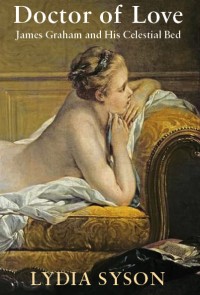It’s amazing how much variety we’ve had with Dr Johnson Reading Circle. We’ve read biographies, poems, diaries, novels, texts on science and romance and a fair bit touching on sex. Another source of variety are the people who come, bringing all sorts of different experiences and backgrounds, some of whom have been the authors of the book under discussion.
At the latest meeting, we were joined by Lydia Syson, author Doctor of Love, a biography of the fascinating and extravagant life of Dr James Graham, eighteenth-century medic, sex therapist, unsuccessful cult founder and the inventor of the celestial bed, a machine that used all the latest technologies to make sexual pleasure more full and conception more likely.
It starts with a vivid description of Graham’s ‘Temple of Health’, a kind of steam-punk wonderland filled with sparking static electricity, gilt, opulence and glass. Then it takes us back into his early life and his probable experiences in learning medicine in Edinburgh, a place where medical theory was undergoing revolution but medical practice was still stuck in the bad old days of bleeding, cupping, blistering and heavy use of emetics and laxatives.
Graham is then spotted as an apothecary in several charitable institutions before turning up in the American colonies with some fanfare, as a doctor specialising in the eyes and ears. The fanfare was, of course Graham blowing his own trumpet, something he was going to do for the rest of his life, his proclamations never underwritten and his skills never under-promoted. Were it not for such self-promotion, the book would have had very little to work from. It is, as Lydia explained, a ‘story in small ads’.
As well as learning the usefulness of mass media, Graham’s time in Philadelphia also taught him about electricity. He would later travel to St Petersburg to learn about magnets before returning to England and setting up practice in Bath. Though important to search out new ideas, it was probably more important for him to be seen doing so.
In Bath he acquired the historian Catharine Macaulay as his patient, a connection that brought him fame, then notoriety when she ran off with and married Graham’s younger brother. He channelled this notoriety, and a lot of borrowed money, into his dream-palace ‘Temple of Health’ at London’s Adelphi. No expense was spared. The place was lavishly decorated, with the largest electric machines, live music, incense and aromas, oxygen and laughing gas abundant and a variety of pills and potions made on the premises. He then became known as the King of Quacks.
We had an interesting discussion over whether we thought James Graham was a quack or not and what a quack even was. His techniques, though unusual, were less harmful than many of the other medical treatments on offer. His education in Edinburgh was just as good, if not better than many other medical practitioners. He recommended such sensible things as a vegetarian diet, fresh air, exercise and cleanliness but was mocked for that advice. It was his travelling around that made him a quack in the eyes of his contemporaries, his showmanship and his use of newspaper advertising and engagement in pamphlet wars. We noted that unlike Dr Darwin and the Lunar Society, James Graham didn’t seem to correspond with other medical people. Rather he seemed determined to drive a wedge between himself and them.
Lydia Syson wondered whether her subject had won her over, whether his charisma had worked its charm on her and taken her in the way it may have his patients. Ian Kelly had similar questions about Casanova when discussing his biography last month. It was striking how similar the answers of the two writers were about what it was that appealed to them about their subject. They were both enchanted by the enthusiasm and energy that their subjects put into life and how their respective lives could be a window to many other aspects of the eighteenth century. James Graham shone a light onto the world of medicine, the theatre and science. We also met up with the Garricks from a different angle, Lady Hamilton at the start of her career (when she was Emma Lyons) and even Walter Scott as a young boy.
At the height of fame, with fashionable society flocking to his lectures and his florid style parodied by newspapers and on stage, Graham decided to open a new facility, ‘The Temple of Hymen’, which would include the fantastical celestial bed. While there were certainly those who saw lewdness in the enterprise, Graham (from all appearances and records) stayed faithful to his wife as he helped other couples have superior sex.
He predicted that every town would one day put up a golden statue of him, in honour of his contribution to the strength, health and wellbeing of the nation. Unfortunately for him, it was a dream built on credit, and he reached far beyond his limit. His grand premises were let to new tenants and his machines were scattered to the winds but Graham didn’t give up trying to bring health to the nation. He developed the mud-bath and proceeded to tour the country, buried neck deep in mud. He died of a brain haemorrhage at 49, shortly after declaring the key to extended life was fasting.
In all her varied work, across genre and subject matter, Syson feels there is a unifying element. Her works are about people with big visions, who wanted to change the word, for better or worse, and what happens when these people’s ambitions meet reality. There may not be a golden statue of Graham up in every town as he had predicted, but there is this book and it serves as a memory to a man who may not have changed the world as he hoped, but who did give it some entertainment (and even a little bit of good advice).



No comments:
Post a Comment